As a stroke survivor, you may have made it home from the hospital. Now you may wonder, now what? Every stroke patient has different experiences, but having some type of physical limitation after a stroke is quite common.
For example, many stroke survivors find that their fine motor skills have been affected. These are the small, precise movements that you need to make to do many common functions in daily life, such as typing, picking up a coin or brushing your teeth. Physical and occupational therapy can help you to practice these movements after your stroke so that you can regain much of your independence.
You also may do exercises at home to boost your fine motor skills. Some exercises that can boost fine motor skills after your stroke include:
- Put pegs into and out of a pegboard, and time yourself doing it. Try to do it faster each day.
- Shoot marbles into a small container three or four times per day. At first, you can use a large cardboard box as your target. As your skills improve, graduate to smaller containers, such as a can or drinking glass.
- Exercise your fingers with rubber bands. For instance, put your most affected hand onto the table and loop rubber bands around your fingers. With your better hand, pull the bands up and down to exercise the fingers on your week hand.
- Take a tennis or racquet ball and squeeze it with your affected hand several times per day.
As you are working to improve your fine motor skills, these movements can be made easier by the purchase of many convenient personal hygiene aids. These stroke aids and stroke supplies can really help to make your daily life easier and lead to a quicker recovery. Some recommended personal hygiene aids are:
- Comfort Wipe – This product extends your reach by more than 15 inches, so that you can more easily clean yourself.
- Hinged Elevated Toilet Seat – This is a traditional elevated toilet seat, but with a hinge, allowing the ring to be brought up in the same way as the regular toilet seat.
Preventing Falls
Falling in the home is a serious risk after you have had a stroke, but there are ways to minimize this risk:
- Use a walker or cane, as your physical therapist recommends.
- Wear non slip footwear when you are walking in the house or standing.
- Check the house for any hazards that could lead to a fall, such as loose stair treads or handrails.
- Be sure there is enough good lighting in the house, and that all walkways are clear of cords and house clutter.
- Have your vision checked every year to make sure that your eyewear is fully up to date.
By working on your motor skills, using personal hygiene aids, and making your home safe from falls, your stroke recovery will be much smoother.



